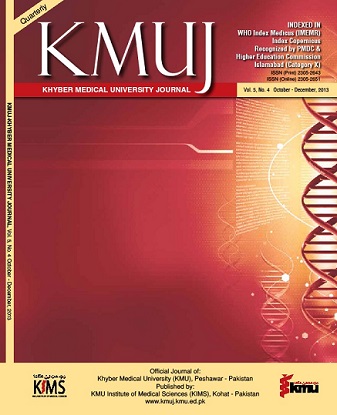OUTCOME OF ECLAMPSIA IN PATIENTS ADMITTED TO ICU AT A TERTIARY CARE TEACHING HOSPITAL
Main Article Content
Abstract
Objective: To determine the outcome of eclampsia patients admitted to intensive care unit (ICU) of Ayub Teaching Hospital Abbottabad.
Methodology: This retrospective descriptive study was carried out at the ICU of Ayub Teaching Hospital Abbottabad, Pakistan. Case records of all patients presenting with eclampsia to the ICU from April 1, 2010 to 30 September 2011 were included in the study. Case records were reviewed and information about patients was collected and tabulated. The results were reported as frequency and percentages.
Results: A total of 116 eclamptic patients were admitted to ICU in this period. Of these 30 (25.9%) patients developed complications and 18 (15.5%) patients died. Two (1.7%) patients left the ICU against medical advice and 2 (1.7%) were referred for nephrologist opinion. Sixty five (56.03%) of these patients were primigravida and 51 (43.97%) were multigravida. Almost all deaths occurred in summer months. Six (5.2%) patients developed acute tubular necrosis (ATN), 5 (4.3%) developed disseminated intravascular coagulation (DIC) while 4 (3.45 %) patients each developed abruptio placentae, HELLP syndrome and septicaemia. Other complications included acute renal failure (2.6%), and post-partum haemorrhage (2.6%).
Conclusion: Eclampsia is responsible for significant maternal morbidity and mortality in our set up. Mortality rate is 15.5% while ATN and DIC are the commonest complications of eclampsia in our patients.
Article Details
Work published in KMUJ is licensed under a
Creative Commons Attribution 4.0 License
Authors are permitted and encouraged to post their work online (e.g., in institutional repositories or on their website) prior to and during the submission process, as it can lead to productive exchanges, as well as earlier and greater citation of published work.
(e.g., in institutional repositories or on their website) prior to and during the submission process, as it can lead to productive exchanges, as well as earlier and greater citation of published work.
References
Sibai BM. Diagnosis, prevention, and management of eclampsia. Obstet Gynecol 2005;105(2):402-10.
Duley L. Maternal mortality associated with hypertensive disorders of pregnancy in Africa, Asia, Latin America and the Caribbean. Br J Obstet Gynaecol 1992;99(7):547-53.
Shaheen B, Hassan L, Obaid M. Eclampsia, a major cause of maternal and perinatal mortality: A prospective analysis at a tertiary care hospital of Peshawar. J Pak Med Assoc 2003;53(8):346-50.
Noor S, Halimi M, Faiz NR, Gull F, Akbar N. Magnesium Sulphate in the prophylaxis and treatment of Eclampsia. J Ayub Med Coll Abottabad 2004;16(2):50-4.
Makhseed M, Musini VM. Eclampsia in Kuwait 1981–1993. Aust N Z J Obstet Gynaecol 1996;36:258– 63.
Sibai BM. Eclampsia. VI. Maternal-perinatal outcome in 254 consecutive cases. Am J Obstet Gynecol 1990;163:1049 –55.
Tabassum N, Umber A, Khan S. Eclampsia: A major cause of feto maternal mortality and morbidity? Ann King Edward Med Uni 2010;16(3):202-5.
Ahmad S, Nazli R, Lutfullah G. Frequency of eclampsia and maternal complications in a tertiary care facility of Peshawar. Pak J Med Res 2008;47(4):79-82.
Rathore R, Butt NF, Iqbal A, Khan MZU. Complications and outcome of patients of pre-eclampsia and eclampsia presenting to medical wards of Mayo Hospital Lahore. Ann King Edward Med Uni 2010;16(1):17-9.
Micheal BB. Eclampsia. Emer Med J 2000; 74: 1-10
Bigdeli M, Zafar S, Assad H, Adbul Ghaffar A. Health system barriers to access and use of magnesium sulfate for women with severe pre-eclampsia and eclampsia in Pakistan: Evidence for policy and practice. PloS one, 2013; DOI: 10.1371/journal.pone.0059158
Ghulmiyyah L, Sibai B. Maternal Mortality From Preeclampsia/Eclampsia. Seminars Perinatol 2012; 36(1): 56–59.
Moodley J, Naicker RS. Mankowitz E. Eclampsia – a method of management. S Afr Med J 1983; 63: 530-535.
Ayesha K, Nargis S. Eclampsia: an aggressive approach is needed. Medical channel 1998: 4; 13-17.
Naseer D, Ataullah K, Nudrat E. Perinatal and maternal outcome of eclamptic patients admitted in Nishtar Hospital, Multan. J Coll Physician Surg Pak 2000;10:261-4.
Bashir A, Aleem M, Shagufta J. Community education and downward trend in maternal deaths due to eclampsia. Specialist Int 1996;12:147-54.
Shiraz S, Boota M, Shahzad S. Eclampsia. Professional Med J Mar 2006; 13(1):27-31
Rauf B, Karim R, Ali S, Jabeen R, Akhtar R. Effect of fit–delivery interval on maternal and fetal outcome in antenatal eclamptic patients. Khyber Med Univ J 2013; 5(3): 141-5.
Begum S, Aziz-un-Nisa, Begum I. Analysis of maternal mortality in a tertiary care hospital to determine causes and preventable factors. J Ayub Med Coll Abbottabad. 2003;15(2):49-52.
Swain S, Ojha KN, Prakash A, Bhatia BD. Maternal and perinatal mortality due to Eclampsia. Indian Paediatr. 1993;30(6):771-3.
Parkash A, Swain S, Seth A. Maternal mortality in India: Current status and strategies for reduction. Indian Pediatr. 1991;(12):1395-400.
